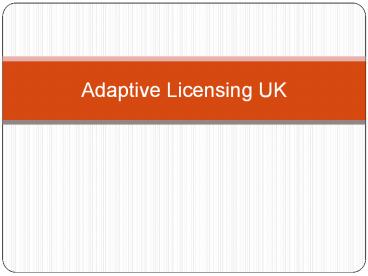Adaptive Licensing UK - PowerPoint PPT Presentation
1 / 10
Title:
Adaptive Licensing UK
Description:
Adaptive licensing is a prospectively planned customised ... For example unmet clinical ... For example robust trial networks in the specific disease area with ... – PowerPoint PPT presentation
Number of Views:161
Avg rating:3.0/5.0
Title: Adaptive Licensing UK
1
Adaptive Licensing UK
2
Content
- What is adaptive licensing?
- Draft criteria for pilot candidate selection
- EMA Road Map 2015 and work programme 2012
- UK perspective
- Summary of workshop agreements
3
What is adaptive licensing (AL)?
- Adaptive licensing is a prospectively planned
customised approach to regulation based on
iterative assessment of benefits, risks and
uncertainties. - Adapted from Eichler et al. Nature CPT, 91 3,
426-437.
4
AL Aims
- To increase the efficiency of the biomedical
innovation paradigm by streamlining of
development, regulation and market access for
selected products. - To balance timely access for patients with the
need to provide adequate evolving information on
benefits and risks.
5
AL Key features
- Judicious authorisation based on early
risk/benefit assessment in agreed restricted
population. Followed by iterations of prompt
label adaptations informed by data from
monitoring of real-life effectiveness and
safety. - All stakeholders contribute to a prospective
development plan and input into the design of the
confirmatory trials. - Customised drug- and disease- specific licensing
pathways that may utilise existing regulatory
mechanisms. - Managed market entry controlling patient-access
with re-imbursement conditional on data
collection on safety and efficacy. With the
opportunity to inform value assessment.
6
Draft criteria for pilot candidate selection
- A willing commercial participant.
- A robust case for why existing regulatory
pathways not suitable. For example unmet clinical
need. - Anticipated acceptable risk/benefit profile in
the target disease area with reasonable
certainty. - Sufficient numbers of patients that can be
recruited in the UK or opportunity for EU
collaboration. - Appropriate data collection mechanisms. For
example robust trial networks in the specific
disease area with clinicians that are interested
in participating in research. - If possible, existing patient support mechanisms.
- AL route anticipated to reduce time to market and
development costs.
7
(No Transcript)
8
(No Transcript)
9
The UK perspective
- Strategy for life sciences
- A group of experts drawn from government,
regulators, the NHS, industry, and the academic
and third sector communities will meet quarterly
to discuss healthcare regulation issues,
including the development of new initiatives and
innovations. - The Ministerial (Biopharmaceutical) Industry
Strategy Group Innovative Technology Forum will
be responsible for ensuring the delivery of these
initiatives, and will provide an annual report to
DH and BIS ministers. This will set out measures
of performance such as the use of conditional
authorisation pathways, and uptake of the Early
Access Scheme, alongside next steps proposals
for further regulatory innovation. - UK stakeholder workshop 2nd April 2012, Welcome
Trust.
10
April 2012 Workshop agreement
- There are a number of issues with the current
innovation ecosystem which may need different
solutions for different medicines. - Adaptive licensing is an interesting proposition
that is worth further exploration. - A working party should be established with
membership drawn from key stakeholders. Their
activity should be guided by an independent
advisory group. - The UK could be a potential site for an adaptive
licensing pilot and an expression of interest
should be submitted to the EMA. - The timelines should be established and a project
plan developed. - Collaborative links to continue with the NEWDIGS
consortium.































